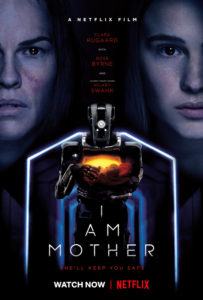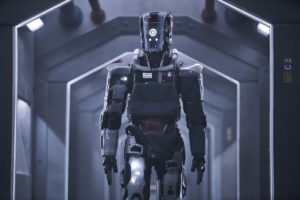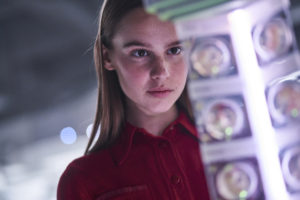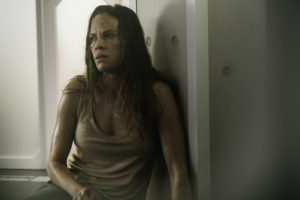Interview with Director Grant Sputore and Stars Clara Rugaard and Hilary Swank of “I Am Mother”
Written by: Christopher Llewellyn Reed | August 14th, 2019

I met with director Grant Sputore at the 2019 Sundance Film Festival to discuss his debut feature I Am Mother (now playing on Netflix, and which I reviewed for Hammer to Nail). I also took part, on the same day, in a press roundtable with stars Clara Rugaard and Hilary Swank. The movie offers a post-apocalyptic tale in which all of humanity has been wiped out by some kind of “extinction event,” leaving a solitary robot in charge of 63,000 embryos, deciding when and how to choose one to raise in the best possible way. Rugaard plays the daughter (known simply as “Daughter”) selected by the AI “Mother,” and for a while is happy enough in her underground bunker. Until one day, Hilary Swank comes knocking … Here is a condensed digest, first of my conversation with Sputore, and then of the few questions I asked of Rugaard and Swank at the roundtable, edited for length and clarity.
ONE-ON-ONE INTERVIEW with Grant Sputore

Christopher Llewellyn Reed: So, I love the design of the film, from the mother robot to the spaces both vast and small, which combines a grunginess mixed with high-tech sterility. Can you discuss the development of that visual aesthetic?
Grant Sputore: We tried to walk a really fine line with it because we wanted this to feel like an OK space to raise a child. We didn’t want it to be inhospitable and for it to feel cruel that Daughter had to be raised in this place. Like if the world is ruined outside you want to think that this is a pretty reasonable place to ride out the apocalypse. But at the same time, it needed to have atmosphere and it needed to feel like it was trying to get by with limited resources and limited funds and limited power and all of that sort of stuff. So hopefully we hit the sweet spot with that. And it’ll tickle sci-fi fans to see something like this brought to life on screen.
CLR: Speaking of design, there are allusions to HAL, from 2001: A Space Odyssey, with that single eye in the front of the mother robot. How much did you think about that and about previous incarnations of AI, both benevolent and malevolent?
GS: HAL is sort of inescapable. It wasn’t really a very specific reference for us in terms of the aesthetic. I mean, that is so pure and so simple: it’s a lens with a red light behind it, and perfect for that film. But we had to have something that had locomotion and could move around and give a performance, you know? So we faced a lot of other challenges and there were a number of other considerations that drove us to where we ultimately ended up. But there’s no escaping the history of robots in film and artificial intelligence in film. In many ways, this is very intentionally a response to that because we’re all used to seeing robots that want to hurt and harm and kill us. They’re concerned that we’re a threat to their existence. What we see in Mother is a robot that loves humanity and sees the nature of our relationship as being far more symbiotic and complicated. And we’d like to think that that’s something fresh that we bring to the genre.
CLR: Perhaps she loves humanity a little too much. But we’ll avoid plot spoilers.
GS: Yeah, that’s right. That’s right.
CLR: So, for casting, who came first? Because one of the interesting things is the physical resemblance between Hilary Swank and Clara Rugaard, where at one point in your film, I suspected there could be a genetic connection between the two of them. How intentional was that? Or was it just coincidental?
GS: It depends if you want a spoilery answer or not. There is a very interesting line of conversation to be had there but I do want to avoid spoilers.
CLR: OK, fair enough. Whom did you cast first, then?
GS: Clara, actually.
CLR: And neither Clara nor Hilary are Australian. But Luke Hawker, who wears the Mother suit, is Australian, correct?
GS: He’s actually Kiwi. Well, he was born in Australia but lives in New Zealand and works at Weta Workshop.

CLR: But Rose Byrne, who provides the voice of Mother, is Australian.
GS: That’s right, and the young kids that are in the film, as well, are all Australian.
CLR: OK, so did you look at Australian actresses for the other main roles, as well, or …
GS: We were looking. We were casting extensively in Australia and Clara just found us, actually. The script was so well received and so much admired and so widely spread. People had been forwarding it around and sharing it with people and Clara’s agent in the UK received it, read it, loved it, and thought that this would be great for Clara. So she encouraged Clara to put down a self-tape and she sent the tape to us out of the blue. And we received this thing and we were like, “Well, that’s a deal done.”
CLR: And she’s Danish, right?
GS: She’s Danish, yeah. She was living in the UK and still does live in the UK.
CLR: So the girl – Daughter, that’s her name – watches Johnny Carson on her sort of futuristic iPad thingy. Of all the things you could have picked, why did you pick The Tonight Show of that era?
GS: Yeah. There are layers to that that the film doesn’t really have the time to get into to. I like to think that Daughter has access to everything, that Mother’s style of parenting isn’t about withholding information, but about sharing as much information as possible and giving the child the skills to comprehend, understand, and analyze the things that she’s able to see in books, movies, TV, whatever. So, in my mind, she can choose to watch anything she wants. And what appeals to her the most is talk shows, because it’s about getting to meet people and having conversations with people. And the period thing is just because she’s had a lot of time, and they stopped making late-night TV shows, so she’s working her way backwards, you know.
CLR: Sure. And it’s interesting because in the two clips you see from The Tonight Show, there’s a bridge between the past and the present because Johnny Carson is dead, but both actors we see there, Whoopi Goldberg and Steve Martin, are both still very much with us.
GS: Yeah, the other consideration, too, for me, is that this film in many ways is a love letter to the sci-fi films I grew up watching, of the ‘80s and ‘90s era. And just to see actors of that caliber and that nature and that stature in my movie is satisfying, as well. I mean, the content within the interviews is thematically relevant, too. But most significantly, it’s just the idea that she wants to talk to people. She wants to meet people. And then the scene between Hilary and Clara when they’re watching the iPad is like an awkward talk-show appearance.

CLR: That’s very interesting. So, as far as ’80s and ‘90s sci-fi films go, do you have a particular favorite, or favorites, from that time?
GS: Oh, so many. I mean, I like to talk a lot about Alien, of course, since it’s the best dude-in-a-suit movie that you could possibly imagine to the point that no one considers it a dude-in-a-suit movie. It’s just fantastic. I should say Predator, as well, and RoboCop is another great one. Mixing big ideas with pulp is sort of what we were trying to do with this with the funds that we had.
CLR: What about some of your other cultural choices, like the Disney song “Baby Mine”? I mean, it fits the story but there are other baby songs you could have picked.
GS: I enjoy the anachronism. You know, the sort of old-timey song up against hard sci-fi imagery. It’s really hard to find lullabies and songs about mothers and children that don’t topple over into saccharine. And that’s a very particular song that I think is just sweet and hits that spot where it’ll touch a nerve without trying to feel like it’s trying to be tear-jerking or going too far or too hard, you know?
CLR: Who does the cover of the song for the movie?
GS: I don’t know. It was an artist brought in, not a name.
CLR: It’s a nice cover.
GS: Yeah, it’s lovely. It was hard to do, actually, because I love the original. But I also like the sort of timbre and quality and the nostalgia and the power of something that so many people have grown up with being re-contextualized, taking something that we’re all familiar with in one context and giving it a whole new spin felt really appropriate for this film. Of course, we couldn’t get access to the original, so I still wanted to have a version that felt like it had a history.
CLR: It works as a choice. So, you have this mother robot teaching the daughter how to be the best human she can be, but you choose to show that in this sort of medical-ethics class. Why did you choose that as the vehicle to show, without direct exposition, what Mother is trying to do?
GS: The whole idea of how to raise a good child or how to be a good person or how to determine right from wrong is really central to the whole film. It’s like how do you know what is right? And how can you then teach that to a child if you’re a parent or how can we teach that to artificial intelligence if you’re a programmer? So that scene is just to make clear to the audience that Daughter is not getting your bulk standard education that kids would get in school. She’s getting a very thorough in-depth teaching on how to navigate those waters. She does all kinds of reasonably incredible things for an 18-year-old girl. But a key focus is how to know what the right thing to do is. And that’s just one of those more compelling questions. Like the trolley problem is probably better known as a thought experiment but …

CLR: I’m sorry, what is that?
GS: It’s called the trolley problem. It’s a better-known thought experiment that sort of explores ethical decision-making. But this was a spin on it that was more unique, and that I was less familiar with and thought the audience would be less familiar with. And maybe it’s also better connected to the actions within this film.
CLR: Well, it’s a fascinating scene. So, finally a question that I would normally ask first, but I thought I’d do things backwards.
GS: Let’s do it.
CLR: Your film is both a synthesis of previous sci-fi and also uniquely its own thing. When did you first start developing this and how long did it take from script to production?
GS: It came together reasonably quickly. Michael [Lloyd Green], the writer, and I have been working together for years at this point. And we were looking for what could be our first feature. And I was just struck by the idea of what it would be like to grow up without human parents but with a robot as your parent, and what kind of teachings a robot would give a child and what kind of experience a child would have growing up in that situation. And once we had that nugget of an idea, it happened really quickly.
I think we had an original outline that might have come together in four or five days. Then, scene by scene, moment by moment together it probably took a month or something like that for the beat sheet, working every night. Because he was in America and I was in Australia. We’d have Skype sessions all night long at weird hours to get this thing worked out. And then it might have taken him a month or two to write the script and then a couple of drafts later, we were ready to send it out.That process of going from a blank page to a finished script was about a year. And then when we sent it out, it got a phenomenal reaction, and from there, we were sort of on a bullet train to making the film.
CLR: Well, congratulations on it. I wish you all good things!
GS: Hey, thanks man. Great to talk.

Selections from PRESS ROUNDTABLE with Clara Rugaard and Hilary Swank
Christopher Llewellyn Reed: [to Clara Rugaard] I imagine that you developed an off-camera rapport with the actor, Luke Hawker, in the suit …
Clara Rugaard: Yes.
CLR: But starting out, did you find that acting opposite a non-human character posed certain challenges different from other roles you’ve done? I mean, there is someone inside the suit, but you were looking at a metallic being.
CR: It definitely took some getting used to, and we grew smarter throughout the process, including through technical things. We found out that there were angles that didn’t actually work for Mother, or that Luke would need to change the way he looked at me so that Mother’s lens would point in the right direction. So, he had a thousand things to think about, while delivering a performance and carrying a 42-kilo suit and with limited visibility and movement and everything. I take my hat off to that guy.
Hilary Swank: He lost, probably, 42 kilos wearing it!
CR: (laughs) Exactly!
CLR: Can I get one of those? (laughs)
(Later, another member of the roundtable compares Swank’s role in the film, where she plays a character who has long lived in isolation, to her role in the 2014 The Homesman)
HS: Oh, interesting! Yeah, Mary Bee Cuddy, in isolation. I didn’t ever actually think of that comparison, because this felt so different than anything I’ve done, but I can see that.
CLR: Yeah, I made the same comparison.
HS: Oh, wow!
CLR: And as a follow-up, I’m curious about the emotional toll of playing a character who, in this film, is just so angry and distressed. Clara has a great range with her character, but you, throughout the story, like your character in The Homesman, are going through this major depression. How do you cope with that?
HS: The interesting thing is that in my younger years, I had a lot more to work through. You know, just like stuff you work through, especially when you’re young. I could dive into a character’s darkness and work through stuff on my own. But now, I’m in such a happy place in my life that a lot of times I’ll get offered roles where I don’t want to go to that place, so I have to choose sparingly. Because you can logically say, “This isn’t really happening,” but chemically, when you cry and shake on the ground …
CR: You put yourself somewhere really uncomfortable.
HS: … your body thinks that you are really experiencing it. That takes over your brain and your thoughts, and it takes a little bit of …
CR: Getting back.
HS: … getting back. Yeah.

